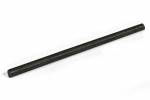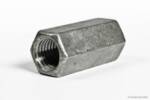Newest FAQs
In 2015, ASTM created a new, all-inclusive specification F3125 to cover A325 and A490 bolts under the same specification. There were many changes made to the specification, but it is still not acceptable to manufacture fully threaded rods in the A325 or A490 specifications. The new F3125 specification states in section 4.1.3: Bolts with thread... Read more

Per the RCSC section 16.2-12, multiple washers are permitted under the nut in order to resolve this problem.
Nuts that are over 2-1/2” diameter do not require a proof load test because most testing equipment in the industry is not large enough to test them effectively. In these cases, a hardness test is an acceptable alternative, unless a proof load test is specifically required by the buyer. Nuts this large would require in... Read more

Only structural steel bolts have an associated tension recommendation. The desired tension on a structural bolt is achieved by using a calibrated torque wrench and a Skidmore-Wilhelm load indicating device to tighten the nut with torque indicated by a verified bolt torque chart. ASTM does not have any recommendations in place for the proper tension... Read more

There are no documented standards for load ratings of coupling nuts or sleeve nuts. These types of connections are not specified for any uses for which load rating would be required. If a connection is used to suspend or tension a load, which is achieved with products like tie-rod assemblies, then the connection products have... Read more

No, mixing and matching different types of galvanized products is not advised. From ASTM A563/A307/A354 and F1554: “4.7.4 When no preference is specified, the supplier may furnish either a hot-dip zinc coating in accordance with Specification F2329, or a mechanically deposited zinc coating in accordance with Specification B695, Class 55. Threaded components (bolts and nuts)... Read more
Both are produced via the hot dip process, but with slightly different processing steps. G90 is a coating grade within the steel sheet specification ASTM A653, and is produced by uncoiling steel coils and running it at high speed through the pickling process and molten zinc before it passes through an air curtain, which creates... Read more
2015 Update: Yes, ASTM A490 bolts can now be fully threaded. There is a supplemental provision in the F3125 specification that allows the bolt to be fully threaded as long as it is stamped with an “S”. The A490 specification starts at ½” diameter and stops at 1-1/2” diameter, and each diameter has its own specific thread length... Read more
Headed bolts are required to be stamped on top of the head, while most rods and some bent bolts are required to be stamped on one end. This Fastener Identification Markings Chart shows the various marking requirements for most common grades of ASTM and SAE fasteners. Headed Bolts ASTM specifications require a manufacturer’s identification and... Read more

Often times, ANSI (American National Standards Institute) or ASME (American Society of Mechanical Engineers) B18.2.1 will show up on a drawing, some certification documents, and even our website . This number simply refers to dimensional standards for a variety of common bolts, such as hex bolts, heavy hex head bolts, and square head bolts. Most... Read more
